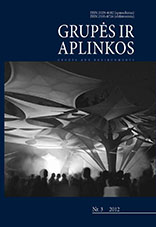Making Sense of Punk Subcultures in the Neoliberal United States
Making Sense of Punk Subcultures in the Neoliberal United States
Author(s): Arnoldas StramskasSubject(s): Cultural Essay, Political Essay, Societal Essay
Published by: Vytauto Didžiojo Universitetas
Keywords: punk; subculture; neoliberalism; Queercore; Riot Grrrl; identity politics; pankai; subkultūra; neoliberalizmas; Queercore; Riot Grrrl; tapatybės politika
Summary/Abstract: The punk phenomenon has been both widely praised and criticized. For some, it has been the ultimate expression of youthful anger and rebellion, especially in the 1980s when the United States was once again returning to a white heteronormative value system and mass consumerism. For others, it is evidence of a postmodern condition where any rebellion is systematically appropriated and pacified through the consumer market. Punk subculture(s) have also been widely criticized both for their inability to live up to self-proclaimed ideals of egalitarianism and for their failure to break away from the social norms structuring larger society. In this paper, I take the rise of hardcore punk subcultures in the early 1980s and the diversification of punk, such as Riot Grrrl and Queercore, in the 1990s as a broad historical framework, while analyzing punk discourses throughout punk history in the US. In providing a broader overview of debates in various disciplines this paper aims to address some of the concerns over issues of the “holy family” of social sciences in the US, namely those of gender/sexuality, race, and class, while situating them within a historico-political context. It also discusses the theoretical considerations of subcultural and popular culture studies by analyzing primary and secondary materials within and about punk subcultures. It is common to assume that subculture, by its very nature, implies exclusivity: who is excluded and why may vary, but exclusions remain prevalent. However, in the neoliberal and identity politics era, these exclusions became more subtle even if more frequently addressed. This paper suggests that punk subcultures can only be analyzed as contradictory: their attempts to create alternatives to the “mainstream” often reproduce similar exclusions concerning identity within a subculture, while their attempts to challenge social order are diffused by the capitalist appropriation of punk’s aesthetics and practices. Pankų subkultūrinis reiškinys yra sulaukęs tiek daugybės teigiamų vertinimų, tiek kritikos. Vieniems tai – aukščiausia jaunatviško maišto išraiška, ypač 9-ojo dešimtmečio pradžioje JAV, kai aktyviai atsigręžta į heteronormatyvias ir vartotojiškas vertybes. Kitiems pankai simbolizuoja postmodernaus būvio praktikas, kai bet kokį maištą sistemingai įtraukia ir nukenksmina rinka. Pankai buvo kritikuojami ir už tai, kad nesugebėjo gyventi pagal užsibrėžtus egalitarizmo ir pasitraukimo nuo socialinių normų idealus. Šiame straipsnyje yra peržvelgiamas istorinis laikotarpis nuo 9-ojo dešimtmečio, siejamo su hardcore punk iškilimu, iki 10-ojo dešimtmečio, kai atsiranda subkultūrinė įvairovė, ypač išplinta Riot Grrrl ir Queercore subžanrai. Šiame straipsnyje pankų subkultūrinė problematika atskleidžiama per lyties, seksualumo, rasės ir klasės prizmę platesniame istoriniame-politiniame JAV kontekste.
Journal: Grupės ir aplinkos
- Issue Year: 2013
- Issue No: 3
- Page Range: 115-129
- Page Count: 15
- Language: English

